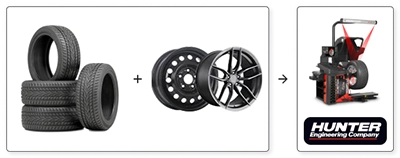Summer Tire Maintenance Guide: Simple Tips For Longer Lasting

For many Canadians, summer is an almost sacred experience: the appearance of the sun after months of winter brings back the feeling of a more pleasant drive! It's also a time to travel to neighboring provinces or the United States!
The experts at PMCtire recommend inspecting your tires regularly in all seasons and changing them when they become unsafe. It's a good habit to check your tires for wear at least once a month or before you travel.
Check the tread
Winter, all-season, or summer tires, one rule remains: they must be in good condition to ensure your safety and that of your passengers! Insert a quarter into the groove of your tire, caribou nose down. If you can still see the caribou's nose, it means your tire has a tread depth of 4.8 mm.
Should you replace your tires? Not necessarily. Some tires, such as Continental or Michelin, are designed to perform as well as new tires, even with this degree of wear. Good tread means the tires can grip the road for braking and steering. In other cases, at this stage, your tires will be more susceptible to hydroplaning and will not perform well on dusty roads.
In any case, a good discussion with a PMCtire expert is the best way to get an informed opinion based on your reality and your driving habits.
Check your tire pressure
Your tires lose pressure every month and can fluctuate with temperature changes. Check your tire pressure every month or before leaving on a long trip. Insert a tire pressure gauge into the valve stem after consulting your vehicle's owner's manual for operating instructions.
Compare your gauge readings to the psi number on the sticker inside the driver's door, and don't forget to check the spare tire pressure. Insufficient air pressure can damage your tires. Driving on overinflated tires can cause a tire to blow out, with the risk of losing control of the vehicle.
Winter tires in summer
Many drivers decide to keep their winter tires on during the summer months. Sometimes because it is too late in the season, other times because they are too worn out for the next winter season anyway.
Your winter tires are designed for winter weather conditions. On the hot asphalt of the summer sun, their rubber degrades more quickly. Winter tires are not made for summer, they offer more resistance on the road. As a result, you use more gas and drive more noisily.
Summer Tire Maintenance - Alignment and Balancing
Tire alignment is the adjustment of the front and rear wheel alignment and camber angle.
Wheel alignment keeps your tires at the correct angle to reduce tread wear, giving you better gas mileage and smoother steering. Signs of misalignment include uneven tire wear, unstable steering or your car pulling to one side (not carrying to the left or right).
Hitting a pothole or driving regularly on rough roads can also affect the alignment of your wheels. Tire balancing corrects the uneven distribution of weight in the wheels.
Properly aligned tires are guaranteed to last longer. Therefore, having your tires professionally aligned will save you money. For a more comfortable ride, it is recommended that your vehicle be aligned once a year or every 20,000 kilometers.
Balancing
Once the tire is mounted, it is possible that the weight of the wheel-tire assembly is not perfectly distributed around the wheel axis.
Balancing prevents vibrations or oscillations that could cause premature wear of certain mechanical parts.
Common symptoms of an unbalanced wheel-tire assembly are uneven and faster tread wear, increased fuel costs, or vibrations in the steering wheel and/or floor that worsen at high speeds.
How do wheels become unbalanced?
As you drive, the wear on your tires changes the shape of the tread and alters the weight distribution on the tire and wheel. By balancing your tires, you can reduce tire wear, maintain good handling and reduce the vibration that can be felt when rolling.
Tire Rotation
Rotating your tires means changing the position of each wheel on your vehicle so that all tires wear evenly and last longer.
All tire manufacturers recommend a monthly tire wear inspection. Summer tires should be rotated according to your vehicle manufacturer's recommendations or every 10,000 to 12,000 km.
If you notice any signs of irregular wear, your tires should be rotated, even if it occurs before 10,000 km.
Because the position of a tire on your vehicle can affect its wear, the regular rotation will ensure that your tires wear evenly. This will extend the life of your tires and improve their performance.


